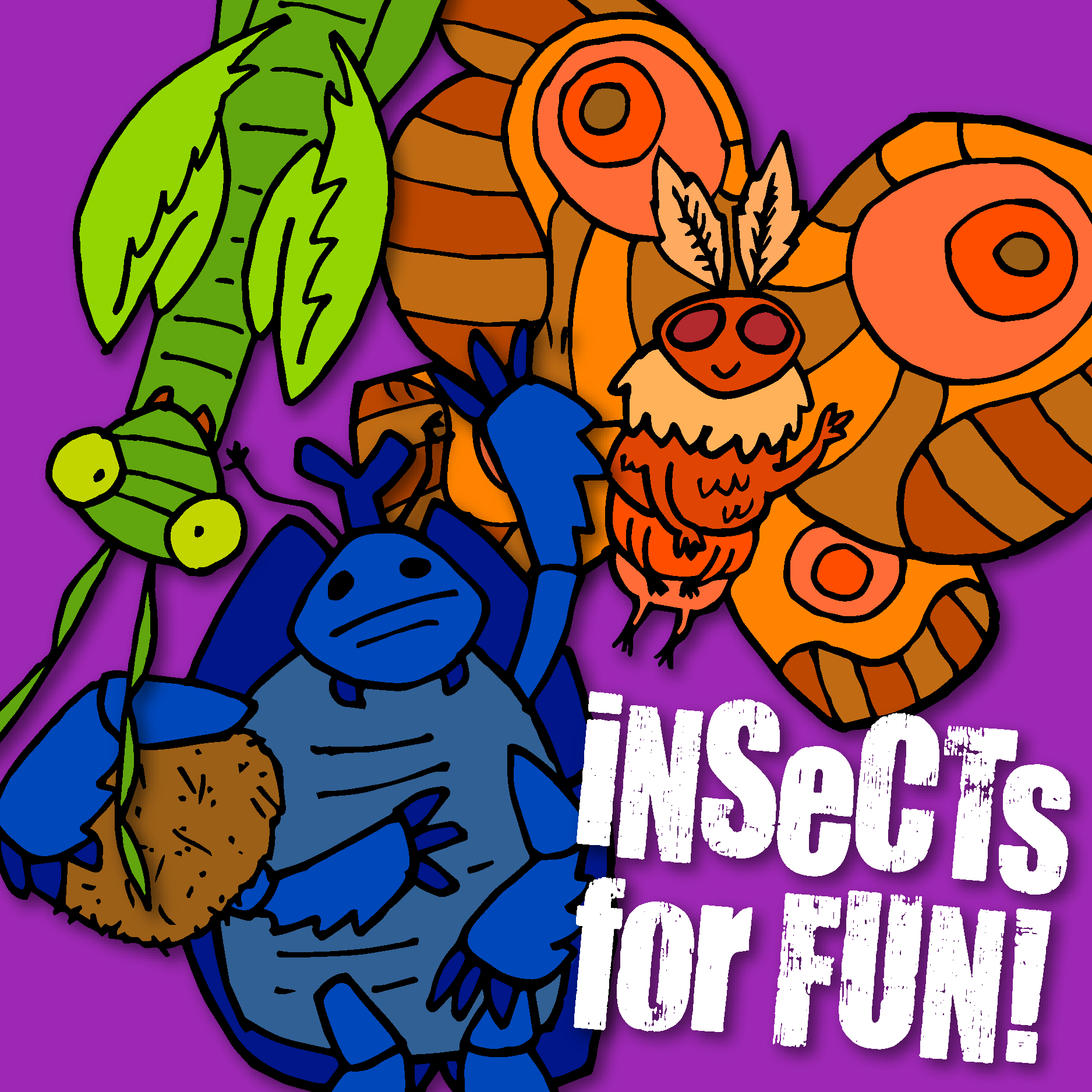Insects for Fun!
An informational podcast covering all things insect and arthropod, hosted by a master in entomology! Join me every Tuesday to learn something new from notable species to broad topics and lore! You can support the show and get extra episodes here: patreon.com/user?u=46499107 Email: Insectsfordummies@gmail.com

Welcome to Insects for Fun!
It doesn't matter if you love or hate insects; this podcast is for everyone! Let's dive into a strange world and uncover crazy facts and mysteries about all things entomology!
Episodes

Tuesday May 21, 2024
Tuesday May 21, 2024
Today we are talking all things millipedes including how they're different from centipedes!
Patreon -> https://www.patreon.com/user?u=46499107
IG: https://www.instagram.com/insects4fun/
FB: https://www.facebook.com/profile.php?id=100085443614825
Email: Insectsfordummies@gmail.com
Discord -> https://discord.gg/pDJH3CYcG6
Today's music was brought to you by Lofi Girl

Tuesday May 14, 2024
Tuesday May 14, 2024
This week was a listener request by Ruth wanting to learn more about centipedes. Learn about some of the crazy things centipedes are capable of along with why you shouldn't play with them.
Patreon -> https://www.patreon.com/user?u=46499107
IG: https://www.instagram.com/insects4fun/
FB: https://www.facebook.com/profile.php?id=100085443614825
Email: Insectsfordummies@gmail.com
Discord -> https://discord.gg/pDJH3CYcG6

Tuesday May 07, 2024
Tuesday May 07, 2024
This week we're looking into the weird creatures known as Skippers! These insects have been an oddity in the order of Lepidoptera and for good reasons. They just don't seem to fit the mold for either moths or butterflies.
Patreon -> https://www.patreon.com/user?u=46499107
IG: https://www.instagram.com/insects4fun/
FB: https://www.facebook.com/profile.php?id=100085443614825
Email: Insectsfordummies@gmail.com
Discord -> https://discord.gg/pDJH3CYcG6
Music provided by Lofi Girl with featured Artist: Blue Wednesday

Tuesday Apr 30, 2024
Tuesday Apr 30, 2024
This week is all about the tiger beetles the incredibly fast and ferocious Coleoptera that can't seem to stay in a taxonomic family.
Patreon -> https://www.patreon.com/user?u=46499107
IG: https://www.instagram.com/insects4fun/
FB: https://www.facebook.com/profile.php?id=100085443614825
Email: Insectsfordummies@gmail.com
Discord -> https://discord.gg/pDJH3CYcG6
Music from LofiGirl with featured Artist: HM Surf

Tuesday Apr 23, 2024
Tuesday Apr 23, 2024
This week we're looking at the wonderful world of insects in the far eastern part of the world. Japan has a booming insect culture that's always been around.
Patreon -> https://www.patreon.com/user?u=46499107
IG: https://www.instagram.com/insects4fun/
FB: https://www.facebook.com/profile.php?id=100085443614825
Email: Insectsfordummies@gmail.com
Discord -> https://discord.gg/pDJH3CYcG6
Music from LofiGirl with featured Artist: HM Surf

Tuesday Apr 16, 2024
Tuesday Apr 16, 2024
Today we are taking a closer look at one of the most easily recognized species of butterflies in the world. The common white or cabbage white butterfly. These insects are easily overlooked, but they've got some pretty cool behaviors and adaptations beneath the surface.
Patreon -> https://www.patreon.com/user?u=46499107
IG: https://www.instagram.com/insects4fun/
FB: https://www.facebook.com/profile.php?id=100085443614825
Email: Insectsfordummies@gmail.com
Discord -> https://discord.gg/pDJH3CYcG6
Today's artists: Shingo Sekiguchi and Kei Kawaguchi.

Tuesday Apr 09, 2024
Tuesday Apr 09, 2024
This week we look at my favorite group of orthoptera, tettigoniidae also known as katydids and bush crickets. Many people get these insects confused for others like grasshoppers or even cicadas (because of their songs) but they hold a special place in the insect class. Today we learn about their songs, behaviors, and much more.
Patreon -> https://www.patreon.com/user?u=46499107
IG: https://www.instagram.com/insects4fun/
FB: https://www.facebook.com/profile.php?id=100085443614825
Email: Insectsfordummies@gmail.com
Discord -> https://discord.gg/pDJH3CYcG6

Tuesday Apr 02, 2024
Tuesday Apr 02, 2024
This week we look into the brief but amazing lives of mayflies covering their behaviors, life cycles, cultural importance, and mating rituals.
Patreon -> https://www.patreon.com/user?u=46499107
IG: https://www.instagram.com/insects4fun/
FB: https://www.facebook.com/profile.php?id=100085443614825
Email: Insectsfordummies@gmail.com
Discord -> https://discord.gg/pDJH3CYcG6
Music featuring: Masaki Tomiyama

Tuesday Mar 26, 2024
Tuesday Mar 26, 2024
This week is all about the beautiful and voracious green lacewing! We learn about their life cycle, their habits, and why people love to have them around their gardens.
Patreon -> https://www.patreon.com/user?u=46499107
IG: https://www.instagram.com/insects4fun/
FB: https://www.facebook.com/profile.php?id=100085443614825
Email: Insectsfordummies@gmail.com
Discord -> https://discord.gg/pDJH3CYcG6
Music featuring Kazuya Morita

Tuesday Mar 19, 2024
Tuesday Mar 19, 2024
This week we break down what it means to be a horseshoe crab and talk about the mechanics behind their blue blood and why it's so important.
Patreon -> https://www.patreon.com/user?u=46499107
IG: https://www.instagram.com/insects4fun/
FB: https://www.facebook.com/profile.php?id=100085443614825
Email: Insectsfordummies@gmail.com
Discord -> https://discord.gg/pDJH3CYcG6










